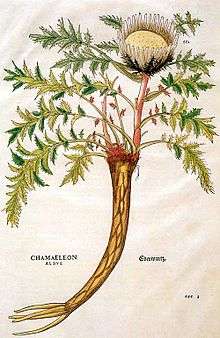De historia stirpium commentarii insignes
De historia stirpium commentarii insignes (Latin for Notable Commentaries on the History of Plants) is a book by Leonhart Fuchs on herbal plants published in Basel in 1542. The work covers about 497 plants and has over 500 woodcut illustrations. Over 100 of the plants in the book were first descriptions.[1][2]
 Title page of the first edition | |
| Author | Leonhart Fuchs |
|---|---|
| Country | Switzerland |
| Language | Latin |
| Genre | folio, herbal |
| Publisher | Isingrin, Basel |
Publication date | 1542 |
| Pages | 896 |

De historia stirpium was illustrated by Albrecht Meyer (who made drawings based on the actual plants), Heinrich Füllmaurer (who transferred the drawings to woodblock), and Vitus Rudolph Speckle (who cut the blocks and printed the drawings).[3]
Reception
The book was initially published in Latin and Greek and quickly translated into German.[4] Just during Fuchs' lifetime the book went through 39 printings in Dutch, French, German, Latin, and Spanish and 20 years after his death was translated into English.[2]
The University of Glasgow states that it is considered a landmark work in its field.[2] Stanford University Press considers it one of the best illustrated books of all time and a masterpiece of the German Renaissance.[5] It set a new standard for accuracy and quality, as well as being the first known publication of plants from the Americas, such as pumpkin, maize, marigold, potato, and tobacco. Plants were identified in German, Greek, and Latin, and sometimes English.[6]
References
| Wikimedia Commons has media related to De historia stirpium. |
- Classen, Albrecht (October 2001). "The Great Herbal of Leonhart Fuchs. De historia stirpium commentarii insignes, 1542". German Studies Review. The Johns Hopkins University Press. 24 (3): 595–597. doi:10.2307/1433419. JSTOR 1433419.
- "De Historia Stirpium". University of Glasgow. Retrieved October 1, 2013.
- "De Historia Stirpium by Leonhart Fuchs". University of Missouri. Retrieved October 1, 2013.
- "Albrecht Meyer". Carnegie Mellon University Libraries. Retrieved October 1, 2013.
- "The Great Herbal of Leonhart Fuchs". Stanford University Press. Archived from the original on July 2, 2014. Retrieved October 1, 2013.
- "Book of the Week – De Historia Stirpivm Commentarii Insignes…". University of Utah. Retrieved October 1, 2013.